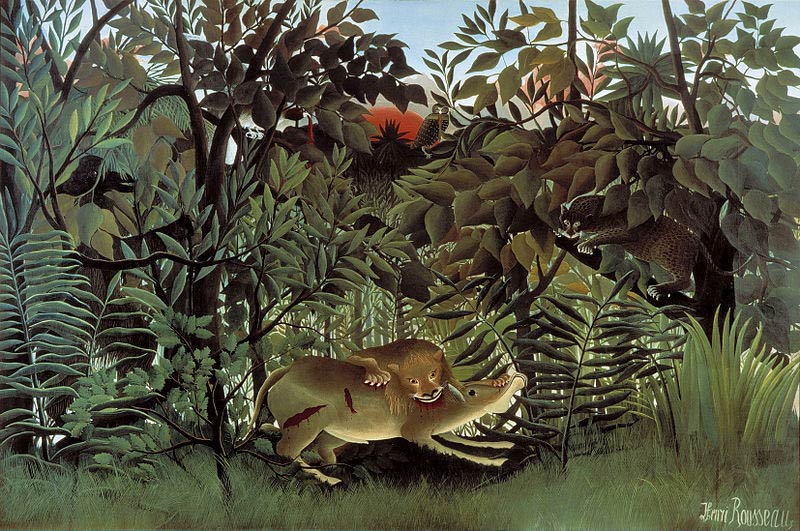| The Hungry Lion Throws Itself on the Antelope | |
|---|---|
 |
|
| Artist | Henri Rousseau |
| Year | Exhibited in 1905 |
| Medium | Oil on canvas |
| Location | Fondation Beyeler, Riehen, Basel, Switzerland |
| Dimensions | 78¾ in × 118½ in |
| 200 cm × 301 cm | |
| Famous Paintings by Henri Rousseau | |
| Tiger in a Tropical Storm | |
| The Hungry Lion Throws Itself on the Antelope | |
| The Dream | |
| A Carnival Evening | |
| The Sleeping Gypsy | |
| The Football Players | |
| The Snake Charmer | |
| Boy on the Rocks | |
| Exotic Landscape | |
| Complete Works |
Though many of the paintings by the post-impressionist French painter Henri Rousseau are scenes of peace in nature, The Hungry Lion Throws Itself on the Antelope is a fairly uncommon depiction of ferocity. The very title tells some, but not all, of what is going on in this lush, typically Rousseauesque jungle.
The lion is hungry and wants to kill and eat antelopes. The antelope seems resigned and even tranquil as it succumbs, its forelegs outstretched in a patch of dark grass. It all reminds one of a James Dickey poem about heaven, where predators endlessly hunt, and preys all but rejoice in being endlessly hunted. Though Rousseau was inspired by a diorama he saw in the Natural History Museum in Paris, he does not even give his lion fangs.
Waiting, Patient Nature
Almost hidden in Rousseau’s beautiful vegetation are a leopard, waiting for scraps. An owl and another meat-eating bird have already torn strips out of the dying animal. An ape-like creature, mostly hidden by leaves, also waits. Like the trees and bushes, the animals form an arc over the trees and bushes that arc over the lion and its victim. This arrangement guides the eye over Rousseau’s foliage, from the hairlike fineness of the gray green grass in the foreground to the green-brown-black of the leaves of the canopy and from there into the calm blue sky and setting sun.
A Not So “Primitive” Painter
Contemplating the lion and the antelope, placed in the lower middle of the picture, also forces the eye back into the depths of the jungle. Though Rousseau was considered a “primitive” painter whose sense of perspective was barely formed, the viewer has the feeling that this jungle is endlessly deep, primeval and has been untouched by humans. Amazingly, Rousseau never set foot in a real jungle and never even left his native France, but drew his trees, shrubs, vines and flowers from what he saw in botanical gardens. His jungles, including the one we see in The Hungry Lion Throws Itself on the Antelope, are really jungles of the mind.